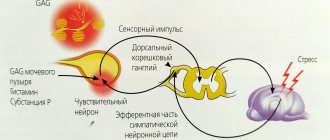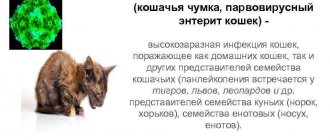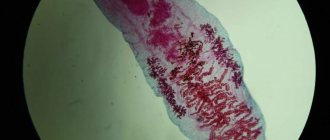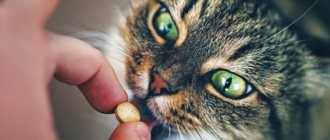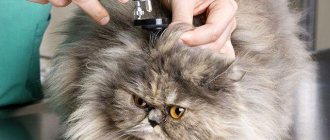The liver in animals performs many complex and vital functions for the body. The health of this organ depends on environmental conditions, the quality of feeding and makes the pet vulnerable to chronic diseases. The most common liver disease in cats is cirrhosis. This pathology causes the proliferation of connective tissue, and therefore the organ ceases to function properly. The disease is practically untreatable and develops unnoticed by the animal owner. In this article, we will look at the causes, symptoms and treatment of liver cirrhosis in cats.
Risk group
Cirrhosis is not transmitted by any means. It represents the slow replacement of liver tissue with scar compounds. Hidden hepapathologies are understood as diseases in which the clinical picture is mild, and the characteristic signs are either just outlined or hidden under other diseases. All animals are susceptible to liver cirrhosis, cats are no exception. Those at risk for developing this pathology include pets with weakened immune systems, the elderly, or those using medications that have a detrimental effect on the organ. In addition, cirrhosis is a consequence of concomitant pathologies.
Primary cirrhosis
The disease occurs for the following reasons:
- Metabolic disease.
- Violation of the outflow of blood and bile.
- Deficiency of vitamins and minerals in the body, especially vitamin B6.
- Hereditary pathologies associated with impaired glycogen metabolism in the liver.
- Poisoning of the body with toxic substances (products of the petrochemical industry, pesticides, drugs).
- Frequent consumption of foods with mold fungi.
- In addition, helminthic infestations lead to the development of toxic liver cirrhosis in cats. This occurs due to poisoning of the animal’s body with waste products of worms.
Causes
If a lot of biological poisons enter the liver, it does not have time to quickly neutralize them and becomes poisoned itself, which is accompanied by the development of an inflammatory process. A connective tissue scar forms at the site of the lesion, and the percentage of functional parenchymal cells decreases. New overloads result in the appearance of further scars, and the ratio of ballast and functional tissue gradually changes in favor of the former.
Toxins may enter the liver for the following reasons:
- Spoiled food.
- Imbalance of the diet in terms of nutrients, vitamins and minerals.
- Feeding cats foods that are not typical for carnivores.
- Contagious diseases.
- Drug intoxication due to misdiagnosis or incorrect dosage.
- Allergic reactions.
Feed spoils due to improper storage. Dry granules may become wet, and natural products may ferment. An animal may steal decomposing meat or fish scraps from a trash can or garbage can. Often the owner gives the cat food that has expired or has become unusable. Feeding mainly fish is dangerous for the cat.
Feeding predominantly fish is dangerous for cats
The stinginess of the owner, trying to save money on the cat’s food, leads to the animal not receiving vitamins and minerals. Metabolism is distorted, metabolic waste is not detoxified, and the immune system is weakened. The vulgar microflora that inhabits the surface of the cat gains access to its textures and begins to actively multiply, releasing toxic waste. The products of tissue breakdown are toxic to your own body. The first target on the path of harmful compounds is the liver.
Beggar
Unreasonable generosity and an attempt to humanize a beloved creature leads to results opposite to those expected. The housewife, consuming delicacies, tries to share them with the cat, offering her smoked, fatty or salted meat. When preparing fish or meat dishes, the beggar gorges itself on scraps and offal.
READ How long do broilers grow for meat: from chick to chicken to slaughter
You'd rather starve than eat anything
Infected animals are subject to attack by the infectious agent on all body systems. The resulting toxic waste products must be inactivated by the liver.
Drug intoxication in most situations is the fault of the owner’s unskilled actions. Kittens often receive medications intended for adults, while cats receive medications designed for humans.
Some drugs used to kill fleas in dogs cause acute or chronic poisoning in cats. Insecticidal collars placed on a kitten under six months of age promote slow intoxication that gradually destroys the liver. Chronic poisoning with unsystematic use of anthelmintics provokes the emergence of inflammatory foci iecur.
Manifestations of a hypersensitive response to stimuli are accompanied by the synthesis of substances that require neutralization and occur in the liver, overstraining the organ and injuring it.
Liver cirrhosis in cats is observed much less frequently than in fellinologists. Because, unlike their owners, pets do not have bad habits that destroy iecur. Most animals often do not live to the age at which old age begins to gradually destroy the body. They die from infections, lack of proper care and attention from the owner, and for other reasons.
The cat lies down most of the day
Cirrhosis is a progressive disease that is accompanied by destructive changes in liver tissue. The disease leads to dysfunction of this organ. Most often, the disease manifests itself in middle-aged and elderly animals. In veterinary practice, it is customary to distinguish between primary and secondary forms of liver cirrhosis in cats. Each of which has its own causes.
Secondary cirrhosis
This type of pathology is registered by veterinarians much more often than the primary form. The causes of secondary cirrhosis are considered to be diseases that are complicated by cirrhosis of the liver. These include:
- Various infectious pathologies (viral, bacterial, fungal).
- Dysfunctions - hepatosis, hepatitis, leptospirosis, adenoviruses.
- Invasion by parasites.
- Heart failure.
Below we will take a closer look at the symptoms and treatment of liver cirrhosis in cats and cats with any form of the disease.
Symptoms
Unlike inflammatory processes in the liver, cirrhosis is hidden and chronic. Up to a certain stage, the disease develops with virtually no symptoms. This is explained by the high regenerative ability of liver cells to recover. Very often, ghost owners confuse the signs of liver cirrhosis with liver failure or other diseases. As a rule, the owner notices the pathology only at the moment when it is too late. And yet, every owner should know the warning signs that indicate the development of cirrhosis:
- Lethargy.
- Apathy.
- Drowsiness.
- Severe fatigue of the animal.
- The cat stops actively moving, spends most of its time lying down and sleeps a lot.
- Decreased appetite and weight. Loss of an animal's body weight is one of the most alarming symptoms of the disease.
- Vomiting, most often mixed with bile.
- Impaired functioning of the digestive system. Alternating constipation and diarrhea.
- Increased thirst.
- Frequent urge to go to the toilet. In this case, the urine takes on an orange tint. This occurs due to undecomposed products of nitrogen metabolism and the release of bilirubin.
- The cat goes to the toilet in small, large portions. Often the owner may notice the puddle is not in the tray.
- Your cat's belly may become larger. This happens with the development of ascites - an accumulation of fluid in the abdominal cavity of the animal.
- In the later stages of the disease, yellowness of the mucous membranes is observed.
In addition to the above symptoms, cats may experience frequent bleeding and poor blood clotting. Symptoms of encephalopathy appear due to severe intoxication of the body. In this case, there is a lack of coordination, convulsions, increased salivation, and changes in the pet’s behavior. Some cats with cirrhosis of the liver meow a lot and become aggressive. In the initial stages, cirrhosis is not very pronounced, which makes identifying the disease difficult.
Clinical manifestations
What are the signs to determine that your beloved domestic cat’s liver has failed? Alas, at first only the most general, nonspecific symptoms appear:
- A strong, unquenchable thirst appears (indicating significant intoxication).
- The feces (most often) become paler than usual, but the urine takes on a rich, orange color.
And only then the signs of liver failure in cats become more pronounced and “intelligible”. Firstly, the volume of the abdomen increases significantly. Even if it’s a cat and there’s no risk of pregnancy in any way. This happens due to ascites (edema of the abdominal cavity). The mechanism of its development is simple:
the volume of the liver decreases, the organ becomes denser, the mouth of the portal vein is compressed, resulting in effusion. If at this moment you press in the area of the right hypochondrium, the animal will show all the signs of a strong pain reaction. At the same time, pronounced yellowness of the mucous membranes and skin develops.
Diagnostics
It is impossible to diagnose liver cirrhosis on your own. If you suspect this disease, you must show the animal to a veterinarian. Carrying out all the necessary research is possible only in a specialized institution. To make an accurate diagnosis, clinics use the following methods:
- Clinical examination. To detect ascites (this disease is associated with cirrhosis of the liver), the veterinarian examines the abdominal cavity. Ascites is diagnosed by palpation.
- In addition, the doctor examines the boundaries of the liver. In cirrhosis, it is increased and goes beyond natural norms.
- Ultrasound. This method is considered the most informative. Using it, you can determine the enlargement of the organ, see the nodes of regeneration foci, and determine the structure of the liver. During the thermal phase, liver shrinkage is most often observed.
- Ultrasound examination of the abdominal cavity. Allows detection of ascites. In addition, you can see an enlarged spleen, which is often found in cirrhosis of the liver.
- General urine analysis. Urobilinogen, bilirubin, leukocytes and red blood cells are found in the urine, and protein appears.
- Blood chemistry. Fibrosis and cirrhosis of the liver in cats are accompanied by a slight increase in the level of protein, cholesterol, prothrombin, and hemoglobin. In the blood test of a sick animal, the concentration of gamma globulins and bilirubin is increased. The level of the latter can exceed its norm several times.
- The disease may also be indicated by a high level of aminotransferase, in particular, aspartate aminotransferase (AST), alanine aminotransferase (ALT), and gamma-glutamyltransferase (GGT). At the same time, the activity of these enzymes increases several times.
- In order for the biochemical blood test to be correct, blood is taken for testing on an empty stomach. An additional veterinarian may use fatty acid levels and, in rarer cases, a liver biopsy.
Cholangitis
Hepatic cholangitis is a disease characterized by severe pain in the side, accumulation of fluid in the abdominal cavity, and cutting sensations when urinating. At the moment, it has not been possible to find out the exact causes of this liver disease. There is an opinion that the impetus may be problems with the animal’s immunity.
With cholangitis, not only the liver, but also the stomach suffers. An increase in blood pressure is also often observed. Therefore, treatment of this disease requires mandatory consultation with a veterinarian.
Treatment
Is it possible to cure cirrhosis of the liver in cats? Unfortunately, the disease has no cure. The liver will no longer be restored. With cirrhosis, the cells of the organ are replaced by connective tissue, which cannot perform the functions of the liver. The only thing that can be done is to make the cat’s life easier. For this, heart medications and medications that improve digestion are used.
When cirrhosis of the liver is diagnosed, the pet’s diet must be reviewed. All proteins are removed from it (or significantly reduced). You can switch to special medicated food, in which the percentage of protein is lower than in regular food. This is done in order to relieve digestion and not strain the liver, since it can no longer cope with the normal digestion of food.
If a cat refuses food and has lost a lot of weight, he is prescribed a glucose drip to restore the animal’s strength, as well as to provide it with the necessary energy. To prevent further death of liver cells, the sick animal is prescribed vitamin therapy. Particular attention is paid to vitamins B and C. In some cases, a sick cat is given Essentiale and other hepaprotectors to somehow help the liver.
If ascites occurs, the animal is prescribed diuretics. If they do not help, an operation is performed - a puncture is made through which excess fluid is removed. If the cat has already started bleeding, then Vikasol or Dicinol is administered to him as a treatment for liver cirrhosis. This speeds up the blood clotting process.
Sometimes a blood plasma transfusion may be required. But in this case, it is important to guess with the blood type, which is taken only from healthy animals.
Treatment of liver cirrhosis in cats
Liver cirrhosis cannot be cured, since the altered cells and tissues are not restored in cats. Liver functions are disrupted, and there are fewer and fewer liver cells. However, it is possible to slow down or completely stop the development of the disease by treating the source of the disease.
The course of treatment is carried out under the strict supervision of a veterinarian, who also prescribes medications and instructions for their use. In addition to eliminating the source of the disease, comprehensive measures are used to support liver function. These actions become:
- Taking medications that improve digestion and heart function;
- If you refuse to eat, nutrient drips are prescribed;
- Increased intake of vitamin complexes by your pet: groups B and C;
- Use of hepatoprotectors;
- In the presence of ascites, diuretics are used, in an advanced stage - surgical intervention with a puncture of the bladder and removal of excess fluid;
- In case of bleeding, blood transfusions and drugs that improve blood clotting are prescribed.
Self-medication for cirrhosis will lead to an early death.
Effect of taking
The drug is prescribed to cats for pathologies of the liver and gall bladder. It has the following effects on the animal’s body:
- protects liver cells from harmful influences;
- prevents congestion in the liver;
- improves bile flow.
This is the most gentle drug for the treatment of cirrhosis in cats. It rarely causes side effects. This drug can be replaced with other human medications only after consultation with a specialist, since many drugs for humans have a negative effect on the animal’s body.
How to use
The dosage of Heptral is determined by the veterinarian; it depends on the cat’s body weight. If you weigh about three kilograms, 0.5-0.7 ml of injection solution is most often prescribed (done intramuscularly).
"Heptral" in tablets is given in a dosage of 80 mg. This is 1/5 of a 400 mg tablet. Experts do not recommend crushing the drug and mixing it into food, since in this case it is poorly absorbed. It is better to put the tablet on the root of the cat's tongue and massage the neck. This will help you swallow the drug.
Tablets or injections
Veterinarians prefer injections. The tablet shell is necessary to protect the active substance from the aggressive effects of gastric juice. When cut into pieces, the coating of the tablet is destroyed, and as a result, the effectiveness of Heptral is slightly reduced. In addition, the drug in ampoules acts much faster. The duration of taking Heptral for liver cirrhosis in cats is about 7-10 days. From time to time the course is repeated. In any case, the period of treatment with this drug should be determined by a veterinarian.
Prevention
Every pet owner should know that prevention of liver cirrhosis, or any other disease, is always better than treatment. Therefore, from the very first day a pet appears in the house, it is necessary to carefully monitor how it eats. You should not feed your cat questionable or spoiled foods. It is also prohibited to give food from the human table.
An animal should not be treated with medications without the permission of a veterinarian. Also, do not increase the dosage, the course of treatment or the number of times the medicine is used. The use of human drugs as therapy for cats is not recommended. Many of them have a destructive effect on the liver.
Pets should be vaccinated on time. Some houseplants are poisonous and should be kept away from animals. It is very important to carry out deworming in a timely manner. In addition, it is necessary to immediately treat primary pathologies: hepatitis, invasions, hepatosis, and so on. If suspicious symptoms occur, you should immediately contact your veterinarian so that there are no questions about how to treat liver cirrhosis in cats.
Hepatitis toxic and infectious
Hepatitis is a liver disease in which the basic functions of this organ, as well as the metabolic processes of the entire body, are disrupted as a result of the breakdown of liver cells.
Depending on the causes of hepatic hepatitis, it is divided into two types:
- Toxic - caused by poisoning from the ingestion of poisons, chemicals, drug overdose, and eating harmful plants;
- Infectious – caused by viral and parasitic diseases, can develop in parallel with other diseases.
Toxic hepatitis is characterized by the following symptoms:
- loss of appetite;
- temperature increase;
- apathetic state of the animal;
- weakening of the pulse;
- difficulty breathing;
- refusal of water;
- change in urine color.
READ Heat in cats (how long does it last and how to help your cat)
When treating this liver problem, a diet and the use of special medications to maintain immunity, antibiotics, and vitamins are prescribed. To avoid a cat getting toxic hepatitis, it is enough to avoid poisoning the animal.
Infectious hepatitis has the following symptoms:
- yellowing of the mucous membranes;
- vomit;
- constipation;
- weight loss;
- temperature increase;
- increased feeling of thirst.
The treating veterinarian prescribes antibiotics, vitamins, glucose and antispasmodics to cats with this disease. At the same time, it is not allowed to give the animal dairy and meat products or broths at the beginning of treatment. You can feed them with porridge and drink decoctions and herbal infusions.
Preventative methods against infectious hepatitis include:
- timely vaccination;
- use of anthelmintics;
- availability of fresh air;
- minimizing contact between the domestic cat and stray animals;
- feeding thermally processed or frozen food;
- use of antiparasitic drugs in the proportions specified in the instructions.
Chance of life
Cirrhosis is a severe liver disorder in cats. The prognosis depends on the stage of the disease. The less healthy tissue left on the liver, the more unfavorable the prognosis will be. According to statistics, sick animals live no more than one and a half years. In this case, the cat must undergo special procedures in the form of intravenous injections, laparocentesis, and also strictly follow nutritional rules.
Liver cirrhosis is a serious and insidious disease. The absence of symptoms in the early stages of the disease does not allow timely treatment. Therapy is only symptomatic and is aimed at improving the animal’s quality of life. Unfortunately, the prognosis for this disease is disappointing.
Forecast
When owners ask how long cats with this disease live, doctors answer differently. It all depends on how severely the damage has affected the liver. Normal liver tissue will not be restored, and the more of it was replaced by connective tissue, the worse. The average statistical life expectancy among cats with this disease is 1-1.5 years. Moreover, throughout its subsequent life, the animal must be regularly examined by a doctor and follow a strict diet.
Finally, I would like to say that cirrhosis of the liver is a terrible disease, in most cases ending in the death of the cat. The high mortality rate from the disease is due to the fact that it does not manifest itself in any way in the early stages. You can protect your cat from a terrible diagnosis with timely vaccinations, a diet rich in vitamins and minerals, regular treatment for worms, and very responsible use of antibiotics in treating the animal. At the first signs of aggravating pathologies such as hepatitis or hepatosis, you should immediately take your pet for examination to a veterinarian.
Liver cirrhosis in cats is a disease in which organ cells die as a result of the proliferation of fibrous (connective) tissue, leading to severe functional impairment. The pathology develops unnoticed by the owner and is practically untreatable.
Caring for a sick cat
In addition to therapeutic measures, special care for a sick animal consists of:
- balanced low-protein diet;
- adding vitamins B, C, K to food;
- taking "Levokartinin" - to improve digestion and increase appetite.
- reducing the pet's physical activity.
- organizing a resting place for the cat so that it can rest peacefully.
Do not give your pet any medications without your veterinarian's permission. In the final stages, the remainder of life is 1-2 years. Therefore, it is necessary to improve the cat’s nutrition, living conditions and treatment as much as possible.
